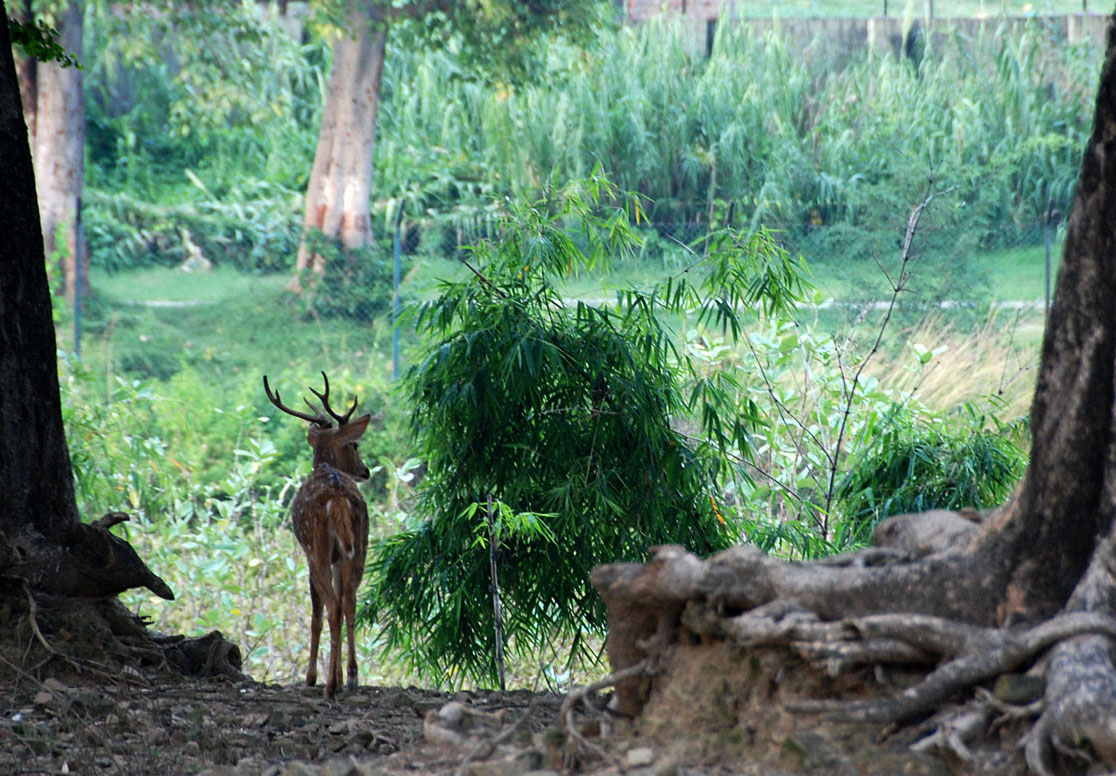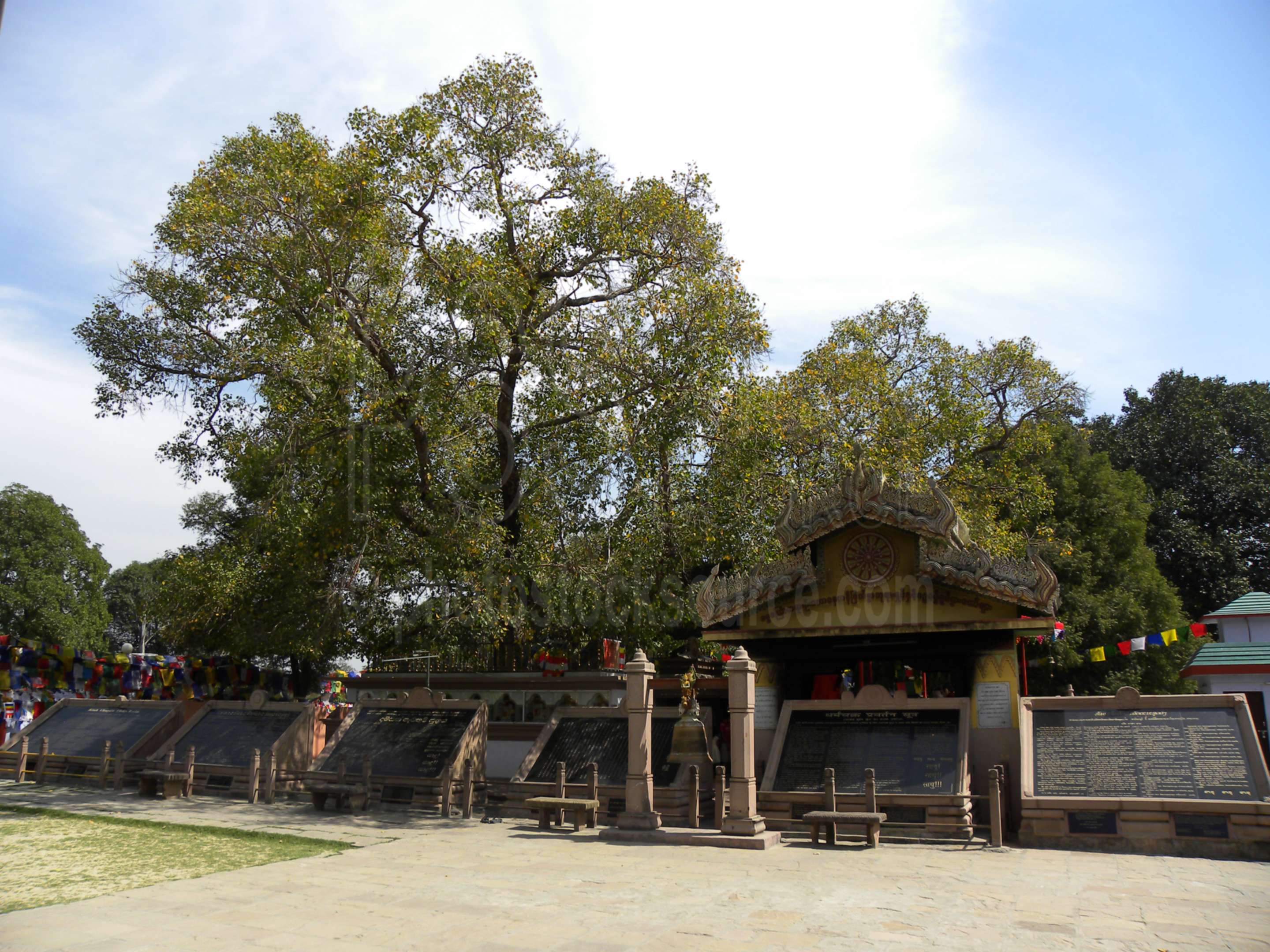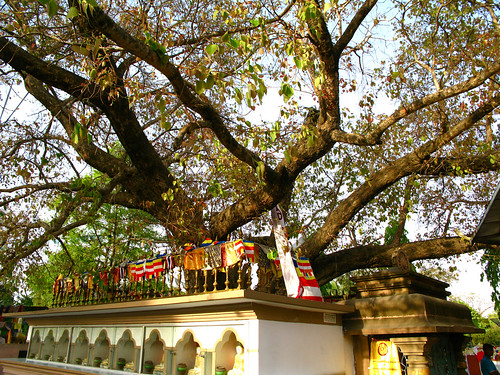Day 9
Sarnath, located just 12 kms from the Hindu holy city of Varanasi, is the site of Deer park ,where Gautam Buddha first taught the Dharma after his enlightenment.It is one of the four holy Buddhist pilgrimage sanctioned by Buddha himself. Gautam Buddha came to Sarnath seeking his five former companions. He found them, taught them and enlightened them. at that time Sangha(the community of enlightened ones) was founded.Sarnath has previously been known as Mrigadava, a 'deer park', Isipatana 'the place where holy men fell to earth'.According to legends, when Buddha was born, devas came down to announce it to 500 holy men.The holy men all rose into the air and disappeared and their relics fell to the ground.The current name Sarnath came from Sarangnath, means 'Lord of the Deer' and relates to another old Buddhist story in which Bodhisattva is a deer and he offers his life to a king instead of a doe he is planning to kill. the king is so touched by his gesture, that he creates the park as a sanctuary for deer.
Places you must see:
Dhamek stupa is an impressive 128 feet high and 93 feet in diameter structure which was built around 249 BC and is the spot where Buddha is said to have preached his first sermon.

Dharmarajika Stupa was pulled down in the 18th century by an officer of Maharaja of Banaras, who was looking for building material for constructing a bazaar.This stupa was built by great Mauryan emperor Ashoka in 3rd century B.C. and is now in complete ruins.This stupa was enlarged five times during different periods and empires.During the tragic demolition, a relic casket of green marble was found. Inside it a stone box was discovered. The box is now preserved in the Indian museum in Calcutta whereas the casket was thrown in river Ganga. During later excavations at the site, two outstanding Buddha images were recovered. They were the colossal Bodhistava from the Kusana period and the seated Buddha of dharma-Chakra-Pravartina mudra from the Gupta period.

Chaukhandi Stupa is thought to have been built as a terraced temple during the Gupta period in 5th century, to mark the significance where Gautam Buddha first met his disciples.Later the Raja's son Govardhan modified the stupa by building an octagonal tower, to commemorate the visit of Humayun, the Mughal emperor.

Mulagandhakuti Vihara ruins mark the place where Gautam Buddha spent his first rainy season. The modern Mulagandhkuti Vihara is a nonastery build by Sri Lankan Mahabodhi Society in 1930. The main attractions are the beautiful wall paintings inside.

Ashoka Pillar is an impressive structure that marks Emperor Ashoka's visit to Sarnath.It is carved out of a stone with the height of 50m.This pillar is depicting four lions on the top in the standing posture back to back and a Chakra (wheel) called as Ashoka Chakra at the bottom.The top is mounted on a fresco, having the images of an elephant, a galloping horse, a bull and a lion.All these animals are separated by an overriding wheels of chariot over a bell shaped lotus.These animal symbolizes the four different phases of Gautam Buddha's life.Elephant stands for Buddha's notion in reference to the dream of Queen Maya, the Bull points out the birth of Buddha which happened during the full moon at the month of Veshak under the zodiac sign Taurus.The horse denotes the horse Kanthaka, which Buddha used for going away from palatial life and the lion shows the attainment of enlightenment of Buddha.The significance of the figures of lion lies in its selection as the official emblem of India, and the inclusion of Ashoka Chakra in the Indian National Flag. Although the Ashoka pillar is in ruined state, collapsed and mutilated during the invasions of the Turks, its ruin still give a feel of its past grandeur.

Tibetan Temple is a beautiful traditional style Buddhist shrine. It enshrines the beautiful statue of Shakyamuni, the Buddha.The walls and ceilings are decorated with frescoes and Buddhist paintings called Thangsa. The prayer wheels which are seen outside the temple building are the major attractions.

Sarnath Archaeological Museum has an impressive collections of artifacts collected from Buddha sites.The sculptures and antiques ranging from 4th century to 12th century are displayed here. Prominent of the collection is the enormous Ashoka pillar. Other outstanding exhibits are Dharmrajika stupa, Saddharmachakra Vihar and images of Buddha and Bodhisattva. The images of various Gods and Goddesses like Lord Krishna, Lord Ganesha and Goddess Saraswati are also found here.

Deer Park is a place where Gautama Buddha first proclaimed the Dharma to the world. He taught his disciples two discourses- the Dhammchakrapavattana sutta and Anattalakhana sutta.This place carries the dignity and reverence as the Buddhist home.

There is also a Bodhi tree (A very large and very old Sacred Fig tree, where Gautam Buddha is said to have achieved enlightenment) planted by Angarika Dhrampala, which was grown from the cutting of the original Bodhi tree at Bodh Gaya.


Sarnath, located just 12 kms from the Hindu holy city of Varanasi, is the site of Deer park ,where Gautam Buddha first taught the Dharma after his enlightenment.It is one of the four holy Buddhist pilgrimage sanctioned by Buddha himself. Gautam Buddha came to Sarnath seeking his five former companions. He found them, taught them and enlightened them. at that time Sangha(the community of enlightened ones) was founded.Sarnath has previously been known as Mrigadava, a 'deer park', Isipatana 'the place where holy men fell to earth'.According to legends, when Buddha was born, devas came down to announce it to 500 holy men.The holy men all rose into the air and disappeared and their relics fell to the ground.The current name Sarnath came from Sarangnath, means 'Lord of the Deer' and relates to another old Buddhist story in which Bodhisattva is a deer and he offers his life to a king instead of a doe he is planning to kill. the king is so touched by his gesture, that he creates the park as a sanctuary for deer.
Places you must see:
Dhamek stupa is an impressive 128 feet high and 93 feet in diameter structure which was built around 249 BC and is the spot where Buddha is said to have preached his first sermon.

Dharmarajika Stupa was pulled down in the 18th century by an officer of Maharaja of Banaras, who was looking for building material for constructing a bazaar.This stupa was built by great Mauryan emperor Ashoka in 3rd century B.C. and is now in complete ruins.This stupa was enlarged five times during different periods and empires.During the tragic demolition, a relic casket of green marble was found. Inside it a stone box was discovered. The box is now preserved in the Indian museum in Calcutta whereas the casket was thrown in river Ganga. During later excavations at the site, two outstanding Buddha images were recovered. They were the colossal Bodhistava from the Kusana period and the seated Buddha of dharma-Chakra-Pravartina mudra from the Gupta period.
Chaukhandi Stupa is thought to have been built as a terraced temple during the Gupta period in 5th century, to mark the significance where Gautam Buddha first met his disciples.Later the Raja's son Govardhan modified the stupa by building an octagonal tower, to commemorate the visit of Humayun, the Mughal emperor.

Mulagandhakuti Vihara ruins mark the place where Gautam Buddha spent his first rainy season. The modern Mulagandhkuti Vihara is a nonastery build by Sri Lankan Mahabodhi Society in 1930. The main attractions are the beautiful wall paintings inside.

Ashoka Pillar is an impressive structure that marks Emperor Ashoka's visit to Sarnath.It is carved out of a stone with the height of 50m.This pillar is depicting four lions on the top in the standing posture back to back and a Chakra (wheel) called as Ashoka Chakra at the bottom.The top is mounted on a fresco, having the images of an elephant, a galloping horse, a bull and a lion.All these animals are separated by an overriding wheels of chariot over a bell shaped lotus.These animal symbolizes the four different phases of Gautam Buddha's life.Elephant stands for Buddha's notion in reference to the dream of Queen Maya, the Bull points out the birth of Buddha which happened during the full moon at the month of Veshak under the zodiac sign Taurus.The horse denotes the horse Kanthaka, which Buddha used for going away from palatial life and the lion shows the attainment of enlightenment of Buddha.The significance of the figures of lion lies in its selection as the official emblem of India, and the inclusion of Ashoka Chakra in the Indian National Flag. Although the Ashoka pillar is in ruined state, collapsed and mutilated during the invasions of the Turks, its ruin still give a feel of its past grandeur.

Tibetan Temple is a beautiful traditional style Buddhist shrine. It enshrines the beautiful statue of Shakyamuni, the Buddha.The walls and ceilings are decorated with frescoes and Buddhist paintings called Thangsa. The prayer wheels which are seen outside the temple building are the major attractions.

Sarnath Archaeological Museum has an impressive collections of artifacts collected from Buddha sites.The sculptures and antiques ranging from 4th century to 12th century are displayed here. Prominent of the collection is the enormous Ashoka pillar. Other outstanding exhibits are Dharmrajika stupa, Saddharmachakra Vihar and images of Buddha and Bodhisattva. The images of various Gods and Goddesses like Lord Krishna, Lord Ganesha and Goddess Saraswati are also found here.

Deer Park is a place where Gautama Buddha first proclaimed the Dharma to the world. He taught his disciples two discourses- the Dhammchakrapavattana sutta and Anattalakhana sutta.This place carries the dignity and reverence as the Buddhist home.

There is also a Bodhi tree (A very large and very old Sacred Fig tree, where Gautam Buddha is said to have achieved enlightenment) planted by Angarika Dhrampala, which was grown from the cutting of the original Bodhi tree at Bodh Gaya.


No comments:
Post a Comment